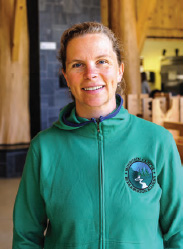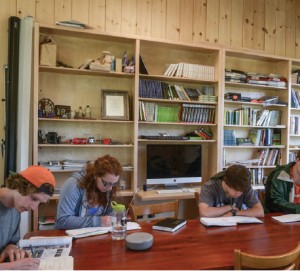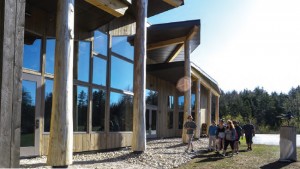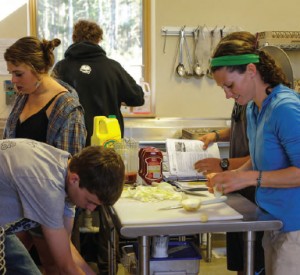By Andrew McKeever
Photography By Hubert Schriebl
Two paths lead to Burr and Burton Academy’s new Mountain Campus. One is the main dirt road that crosses a bridge and after a short rise brings into view the main building with its two adjacent solar panels. Then there’s the Wright Way, which is how the students get to class. Named for a former trustee of the school, Mark Wright, who played an important role in bringing the vision of an outdoor, nature-driven curriculum into reality, it’s a serpentine trail that parallels the road from the parking area off Hapgood Pond Road. It clings to the side of a hill that bottoms out at the riverbed of Jones Brook, one of the streams that flows through the roughly 100 acres that make up the campus that straddles the border of Landgrove and Peru.
Up here, everyday is a walk-to-school day.
One of the several chores the 20 or so students have to do is maintain the path, even in the winter when there’s snow to be shoveled. There is no maintenance crew at the Mountain Campus, so the students and four faculty members share the burdens of cleaning, cooking meals and maintaining the building. Doing some of the chores is how a typical day starts, says senior Sarah Maness of Pawlet, one of the students enrolled in the semester-long program last spring.
“The bathroom crew is the most prestigious crew,” she says with a smile, adding that there’s little bickering among the students about having to perform those tasks. It builds a sense of bonding and camaraderie, and there’s a palpable sense of that as you walk around and watch the students interact.
Sophomore Nicholas French of Manchester is one of them. After spending the past four months on the Mountain Campus, the experience has had a big impact, he says.
“I was really shy when I came up here,” he says. “I was kind of intimidated by the whole thing at first. It was different from what I was used to. But I figured I had eight semesters of high school, so I might as well try something different.”
“Something different” is as good a way of summing up the experience of spending a semester at the Mountain Campus as any, agreed Ben Freeman, the program’s director.
Start with the main building. Perched on a clearing that looks out over a spectacular expanse of the Green Mountain National Forest, the 2,600-square-foot structure was designed to minimize its environmental impact, he says.
The wilderness that surrounds the campus may be their primary laboratory and classroom, but the building plays a major role as well.
Designed by architect Randal Walter of Walpole, N.H.-based Bensonwood, a construction firm that specializes in eco-friendly structures, the goal is to obtain LEED (short for Leadership in Energy and Environmental Design) platinum certification by the U.S. Green Building Council; the best rating a building can have for energy efficiency and carbon emissions neutrality.
It’s the starting point for the central question around which the curriculum of the Mountain Campus revolves—“What does it mean to live well in this place?”
There are at least two levels to that question. One is an obvious one—stewardship of the land. By starting with an understanding of this area, viewed from scientific, historical and literary perspectives, students develop an attachment for it. A motivation to protect and preserve it will follow, Freeman says.
But the Mountain Campus experience is meant to go well beyond that. Out of the interaction with the natural elements and gleaning insight into the biological network that makes up a forested mountain environment, comes the realization by the students that they are capable of more than they thought. Bigger challenges no longer seem so intimidating or unconquerable.
“The interesting thing about our curriculum and part of what makes it hard to understand is content is the less essential piece—it’s skill and understanding that we’re really trying to teach,” he says. “What we try to do is define the skills and habits of the kind of people who are very active at creating positive change in their communities and environments.”
Several academic disciplines converge in the study of this place in Peru. There’s an obvious scientific one; the factors that influence the forest landscape and why it looks as it does. But the campus is also an historical laboratory. How have people lived here through time? How did early colonists and native populations live in this place? How did this place get to be the way it is now?
From there, a literary layer is introduced. Nature writers such as Henry David Thoreau are read and studied, along with other writers whose works have been inspired by interactions with landscapes.
The Mountain Campus is also a base for other explorations further afield. Over the course of a semester, students go on several field trips.
The semester-long course starts with a two-night orientation stay at the campus. Then, after a month or so, students and faculty embark on a four-day trip, which last year involved following Jones Brook up to its headwaters on the Green Mountain Ridge west of the campus. As it turns out, the ridgeline contains the headwaters of three rivers that flow out to the Atlantic Ocean. Jones Brook eventually finds its way to the Connecticut River and south to Long Island Sound and the ocean beyond. Otter Creek flows north towards Lake Champlain and on out through the St. Lawrence River to the North Atlantic. And the Battenkill’s headwaters rise nearby as well, from which the river flows south and west to the Hudson River, and on to New York City and so forth to the ocean.
This trip combines a lot of Mountain Campus basics, says Freeman.“On that trip we investigate the concept of headwaters and watersheds and the ecological ramifications of that,” he says. “But a huge element was the student leadership—navigation, campground management and expedition behavior.”
The students will make another trip out beyond the campus, which could be a journey like one last year which saw them head up to northern Vermont for talks with business owners and farmers around sustainability issues. The students were trying to determine what residents are doing to promote change locally in ways that produce a “triple bottom line” surplus—a profit making enterprise, social value and ecological benefits.
What type of student is attracted to the Mountain Campus program and who gets accepted into it? Students have to apply, and write a letter outlining their interest. That’s followed up by face-to-face interviews, Freeman says.
“What we’re looking for are adventurous, but not rash, motivated, persistent in the face of adversity, caring students,” he says. We look for students willing to work hard. Emotional and intellectual maturity count for a lot.
There were about 20 students in each of the first two semesters, and in theory the campus could expand to accommodate roughly twice that number, but no one sees it getting any larger than that. Beyond that, the concept of community could start to break down.
The program costs nothing extra to attend and all the basic equipment is provided, from backpacks and muck boots to the food the students cook and eat every day. “We wanted to make sure that all students could attend, regardless of their economic situation, mirroring the richness and real diversity of experience and perspective at BBA,” Freeman says.
Students are graded on a pass/fail basis, but receive extensive, even exhaustive written assessments from the four-member faculty, which includes Freeman, Paul Kelly, Cindy Mowry and Jillian Joyce.
Because of the field trips and the longer school day on the Mountain Campus compared with the main campus in Manchester, it’s also an “all-in” kind of program that rules out extracurricular activities such as sports or theater, says teacher Paul Kelly.
“We thought long and hard about that,” he says. “But logistically and philosophically it just doesn’t work for our students to spread themselves too thin.”
After their morning meeting and chores, the day begins with a two-hour long academic period. The students could be all together or split up into groups. After a lunch break, there’s another two to three-hour long academic block before an end-of-day meeting is held to discuss the day, and assign the next day’s projects. Shortly after 3:30, the students hike back to the bus. They arrive back on the main campus around 4 p.m.
Paul was one of the faculty first approached by BBA’s former headmaster, Chuck Scranton, when the idea for an outdoor learning-based campus and program was first discussed about ten years ago. He leapt at the opportunity to get involved in helping develop it, he says. “I was immediately excited about it,” he recalls. “It took seven years (to put it together) instead of two, but it was worth the wait.”
Scranton remembers a retreat he and the school’s trustees went on back in 2003 when the school officials had to come up with a solution to a pressing problem facing Burr and Burton at the time—overcrowding.
Despite an aggressive expansion of classrooms and facilities on the main campus, the school was facing the prospect of needing even more classroom space back then. But there was no room left on the 29-acre campus to construct new buildings, Scranton says.
By creating a separate campus focused on nature and the environment, two good things would happen—the space crunch would be alleviated, and a new educational experience would be offered to Burr and Burton’s students.
The idea of using the outdoors as a learning laboratory had long appealed to Scranton. By creating a separate campus focused on nature and the environment, two good things would happen—the space crunch would be alleviated, and a new educational experience would be offered to Burr and Burton’s students.
So the search for an off-campus site began, which led them to the 100 acres that was quietly being put on the market off Hapgood Pond Road. Scranton looked at the land one day with trustee Mark Wright, and both were enchanted by its beauty, remoteness and the fact that it was full of wetlands and diverse eco-systems, he says.
A lengthy Act 250 process followed, along with the need to allay local concerns among area residents that their quiet communities were not going to be overrun with high school students and school buses. Plus there was the matter of raising about a million dollars or so to purchase the land and develop the property. This stretched the start up of the program from what was going to be two years to more like five or six.
And by then, times had changed, says Scranton. “What started out as a real issue of overcrowding faded because of the demographics in the elementary schools. What took over as a motivating idea and sustained the momentum was this incredible educational opportunity for students to spend a semester away from the main campus, rolling up their sleeves and experiencing learning first-hand and hopefully getting passionate about what they were doing,” he says. “Environmental stewardship and sustainability were key tenets of the program, but in many ways they were a vehicle for English and social studies that were embedded into the program. The real goal is for kids to develop a sense of confidence and self-reliance and the passion for learning.”
Mark Tashjian, Burr and Burton’s present headmaster, and on whose watch the new campus finally opened for business last year, remembers his first look at the location when he was interviewing for the top job at the school in 2007, after Scranton had announced his plans to step down.
Mark Wright and his three dogs, along with Tashjian, piled into Wright’s pick up truck one day and headed for Peru. They went for a hike across the property and Tashjian remembers thinking it was magical. If he didn’t get the headmaster’s job at BBA, he planned to reapply to become the director of the Mountain Campus, he says now with a chuckle. “You could see endless possibilities for how kids could take that landscape and turn it into a tremendous learning experience,” he says.
Since 2008, the concept has been tweaked considerably. The original size of the building was reduced. A lot of thought went into designing the curriculum, which is not meant to be anything like what students get on the main campus. If all they did in Peru was open the same textbooks they do in Manchester, the whole point of the new campus would have been a waste of time and money, Tashjian says. “The purpose of a place-based program is to study what’s there,” he says.
But how does this play when it comes time to apply for college? What are admissions departments supposed to make of this program was one question raised by students and parents as the concept began to come into focus.
Both Freeman and Tashjian think an experience like the Mountain Campus on a college application should hold a college applicant in good stead.
“Think about it—if you were a college admissions director and you had a choice between a kid who stuck to the mainstream path and a kid who did something different and could write about it or talk about it in a compelling way, you’re going to pay attention to that kid,” he says. “So I see the Mountain Campus as nothing but a plus for college admissions.”
Right now, the program is open to students at BBA who are between grades 10-12.
“I want each kid to … say it’s the greatest thing they’ve ever done, to have it be transformational with great lasting meaning—it shaped how I view the world, myself and how I interact with the community and what I want to do in my life,” he says. “Different is good; you try something different that’s hard, it makes you grow. You don’t grow by doing the same thing over and over and never getting out to the edge of your comfort zone.” ◊
Andrew McKeever is a frequent contributor to STRATTON MAGAZINE.





